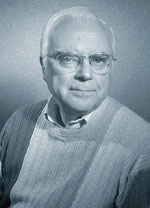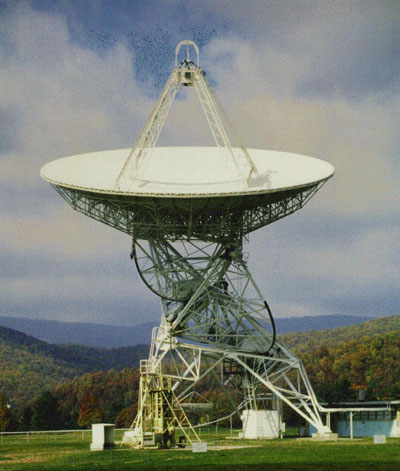“SETI 的历史 - 4”的版本间差异
| 第6行: | 第6行: | ||
At around the same time that Morrison and Cocconi were speculating about alien signals, a young astronomer named Frank Drake was pursuing his own investigations into interstellar communications. Drake was a staff member at the National Radio Astronomy Observatory at Green Bank, West Virginia. At the time, the newly established NRAO was in the odd position of being a radio observatory without a radio telescope. The 140-foot dish panned for the site was in the early stages of what turned out to be a very troublesome construction. It would not be completed until years later. As a stopgap measure, the NRAO purchased an 85-foot radio telescope, which became operational in April of 1959. | At around the same time that Morrison and Cocconi were speculating about alien signals, a young astronomer named Frank Drake was pursuing his own investigations into interstellar communications. Drake was a staff member at the National Radio Astronomy Observatory at Green Bank, West Virginia. At the time, the newly established NRAO was in the odd position of being a radio observatory without a radio telescope. The 140-foot dish panned for the site was in the early stages of what turned out to be a very troublesome construction. It would not be completed until years later. As a stopgap measure, the NRAO purchased an 85-foot radio telescope, which became operational in April of 1959. | ||
| − | + | 正当 Morrison 和 Cocconi 揣摩着外来信号的同时,一位年轻的天文学家 Frank Drake 继续进行自己的星际通讯研究。Drake 是西佛吉尼亚州绿岸国家射电天文台(NRAO)的一名工作人员,当时,新成立射电天文台的 NRAO 位于偏移的地区并没有射电望远镜。建造直径140英尺(42.672米)的单碟计划在早期来说是非常棘手的,它在许多年以后才被建成。当时作为权宜之计,NRAO购买了一个直径85英尺(25.908米)射电望远镜,并与1959年4月开始运作。 | |
2009年6月13日 (六) 21:40的版本
<资料来源:The Planetary Society>
第4章:Ozma项目的起源
At around the same time that Morrison and Cocconi were speculating about alien signals, a young astronomer named Frank Drake was pursuing his own investigations into interstellar communications. Drake was a staff member at the National Radio Astronomy Observatory at Green Bank, West Virginia. At the time, the newly established NRAO was in the odd position of being a radio observatory without a radio telescope. The 140-foot dish panned for the site was in the early stages of what turned out to be a very troublesome construction. It would not be completed until years later. As a stopgap measure, the NRAO purchased an 85-foot radio telescope, which became operational in April of 1959.
正当 Morrison 和 Cocconi 揣摩着外来信号的同时,一位年轻的天文学家 Frank Drake 继续进行自己的星际通讯研究。Drake 是西佛吉尼亚州绿岸国家射电天文台(NRAO)的一名工作人员,当时,新成立射电天文台的 NRAO 位于偏移的地区并没有射电望远镜。建造直径140英尺(42.672米)的单碟计划在早期来说是非常棘手的,它在许多年以后才被建成。当时作为权宜之计,NRAO购买了一个直径85英尺(25.908米)射电望远镜,并与1959年4月开始运作。
As a junior staff member in Green Bank, Drake had a part in many of the radio-astronomy projects at NRAO. His fascination, however, was with the search for alien civilizations. As a graduate student in radio astronomy at Cornell, Drake had once detected a strong seemingly artificial radio signal coming from the direction of the Pleiades. After weeks of analysis, Drake had concluded that the signal in fact originated on Earth, but the possibility of detecting an alien radio signal remained very much on his mind.
In March of 1959 Drake calculated that if a strong radio signal would be sent from Earth, using existing technology, it could be detected at a distance of 10 light years by an 85-foot dish. In other words, the new radio telescope at Green Bank should be capable of detecting signals as far as 10 light years away, even if they are sent by transmitters no more powerful than the ones then available on Earth. Drake noted that there were several sun-like stars within a distance of 10 light years from Earth. These, he reasoned, were good candidates for beginning the search for alien intelligence.
One day, during lunch at a greasy spoon diner not far from the observatory, Drake broached the topics with his colleagues. Would it be possible to use the new radio telescope then being built at Green Bank to search for extraterrestrials? It was, undoubtedly, Drake's good fortune that unlike the Jodrell Bank radio observatory, which had rejected Morison and Cocconi, the Green Bank dish was not yet operational and therefore could be flexible about its future schedule. He was also fortunate that Lloyd Berckner, acting director of NRAO, was present at the lunch that day, and gave Drake's proposal the go-ahead. Drake dubbed the venture "Project Ozma," after Princess Ozma of Oz, from Frank L. Baum's classic tale.
The months that followed were a busy time in Green Bank. But even while the new radio telescope went on-line and began collecting data, Drake and his colleagues kept up work on Project Ozma. For cost-saving reasons, they decided to concentrate on the hydrogen 1420 MHz band. That was the frequency at which radio telescopes most commonly operate, and it would therefore require the least alterations in the existing equipment. In the end, the price tag for parts unique to Ozma amounted to no more than $2000.
Two events combined to speed up project Ozma in late 1959. One was the appointment of Otto Struve as the first permanent director of NRAO. Struve was famous for his work on the measurement of stellar rotation, which he argued could indicate the presence of planets orbiting distant stars. In Struve's mind, it was only a short leap from extrasolar planets to extraterrestrial intelligence: he supported Ozma wholeheartedly. Furthermore, he brought to the effort his extensive connections and his flair for public relations. Whereas Drake and his colleagues, fearing for their academic respectability and their peace of mind chose to keep the project a secret, Struve went public immediately in a lecture at MIT. "The cat was out of the bag," Drake recalled years later. "Looking back now, only good came from letting it out." While the dreaded wave of publicity did indeed follow, so did public support and valuable donations in money and equipment.
The other event was the publication of Morrison and Cocconi's article in Nature in September of 1959. Drake was pleased that such prominent researchers were working along similar lines to his own. In particular, Morrison and Cocconi provided theoretical support for searching at the very same frequency that Drake chose for cost-saving reasons - 1420 MHz. Struve, however, was concerned that the Ozma team would be robbed of their due credit, and he urged Drake to begin the search as soon as possible.
第3章:SETI的蓝图 ← | → 第5章:Ozma项目 - 搜索

